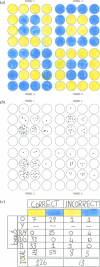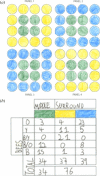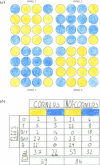Blackawton bees
- PMID: 21177694
- PMCID: PMC3061190
- DOI: 10.1098/rsbl.2010.1056
Blackawton bees
Abstract
Background: Real science has the potential to not only amaze, but also transform the way one thinks of the world and oneself. This is because the process of science is little different from the deeply resonant, natural processes of play. Play enables humans (and other mammals) to discover (and create) relationships and patterns. When one adds rules to play, a game is created.
This is science: the process of playing with rules that enables one to reveal previously unseen patterns of relationships that extend our collective understanding of nature and human nature. When thought of in this way, science education becomes a more enlightened and intuitive process of asking questions and devising games to address those questions. But, because the outcome of all game-playing is unpredictable, supporting this 'messyness', which is the engine of science, is critical to good science education (and indeed creative education generally). Indeed, we have learned that doing 'real' science in public spaces can stimulate tremendous interest in children and adults in understanding the processes by which we make sense of the world. The present study (on the vision of bumble-bees) goes even further, since it was not only performed outside my laboratory (in a Norman church in the southwest of England), but the 'games' were themselves devised in collaboration with 25 8- to 10-year-old children. They asked the questions, hypothesized the answers, designed the games (in other words, the experiments) to test these hypotheses and analysed the data. They also drew the figures (in coloured pencil) and wrote the paper. Their headteacher (Dave Strudwick) and I devised the educational programme (we call 'i,scientist'), and I trained the bees and transcribed the childrens' words into text (which was done with smaller groups of children at the school's local village pub). So what follows is a novel study (scientifically and conceptually) in 'kids speak' without references to past literature, which is a challenge. Although the historical context of any study is of course important, including references in this instance would be disingenuous for two reasons. First, given the way scientific data are naturally reported, the relevant information is simply inaccessible to the literate ability of 8- to 10-year-old children, and second, the true motivation for any scientific study (at least one of integrity) is one's own curiousity, which for the children was not inspired by the scientific literature, but their own observations of the world. This lack of historical, scientific context does not diminish the resulting data, scientific methodology or merit of the discovery for the scientific and 'non-scientific' audience. On the contrary, it reveals science in its truest (most naive) form, and in this way makes explicit the commonality between science, art and indeed all creative activities.
Principal finding: 'We discovered that bumble-bees can use a combination of colour and spatial relationships in deciding which colour of flower to forage from. We also discovered that science is cool and fun because you get to do stuff that no one has ever done before. (Children from Blackawton)'.
Figures



Comment in
-
Blackawton bees: commentary on Blackawton, P. S. et al.Biol Lett. 2011 Apr 23;7(2):166-7. doi: 10.1098/rsbl.2010.1057. Epub 2010 Dec 22. Biol Lett. 2011. PMID: 21177691 Free PMC article. No abstract available.
Publication types
MeSH terms
LinkOut - more resources
Full Text Sources
Other Literature Sources
Miscellaneous

